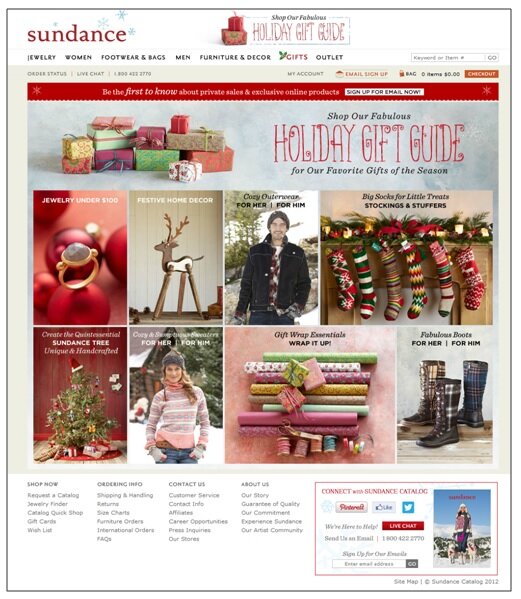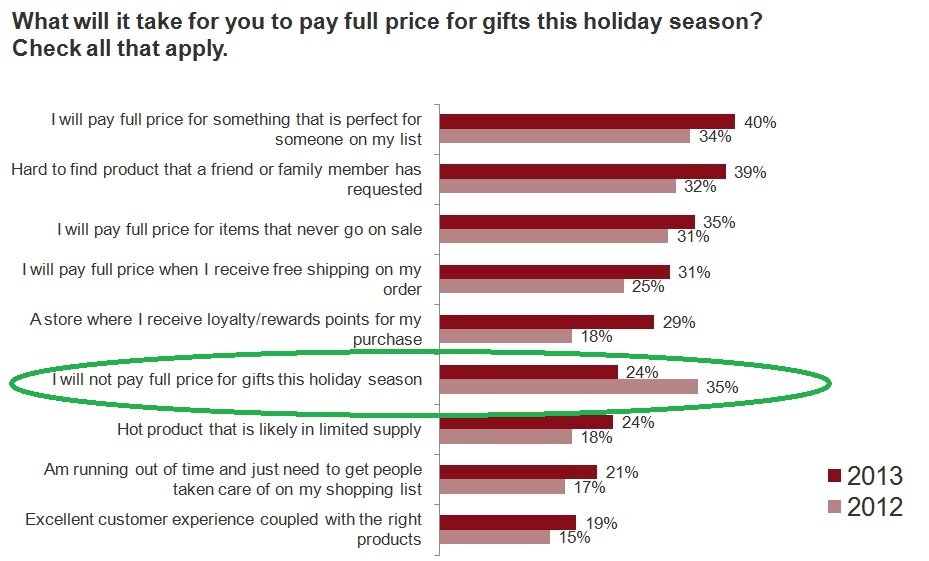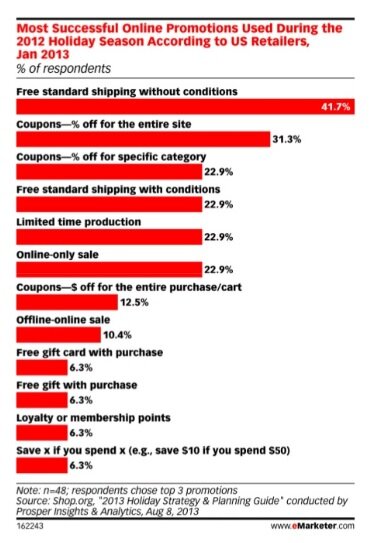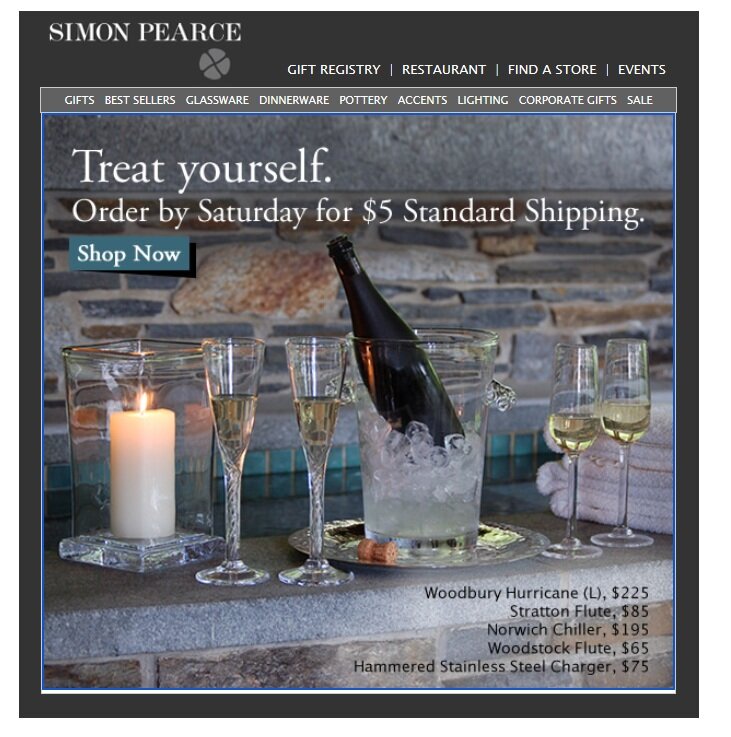Webinar recap: 3 reasons to be optimistic this holiday season
October 11, 2013 Leave a Comment
There was a plethora of information in Wednesday’s webinar reviewing the results of the 2013 MarketLive/E-Tailing Group Holiday Shopping Survey. While we’ll cover specific themes and tactics in the weeks to come, we thought it worthwhile to set the tone for the holidays with some uplifting news: this year has plenty of potential to reap great rewards for merchants.
It’s certainly true that merchants will face stiff competition and plenty of challenges this holiday season, as we reported in our recent post on holiday sales forecasts. The National Retail Federation’s predicted overall retail sales growth rate of 4.1% is almost 27% lower than the recent highs of 2010 and 2011, which both saw gains of 5.6%. And in Wednesday’s webinar, E-Tailing Group president Lauren Freedman said that 47% of merchants surveyed said they’re nervous about not meeting aggressive sales goals, while more than a third said they believed the year would result in flat sales growth at best.
But the webinar also pinpointed a number of areas where consumers themselves indicated they’re both ready to spend and receptive to merchant offerings. Here are three reasons to feel confident heading into the season — and three ways to translate the opportunities into tangible tactics:
Shoppers are willing to buy more, in more categories, than ever. Fully 40% of consumers said they planned to make more holiday purchases online this year than last year, and for almost every product category the percentage of shoppers planning purchases has risen significantly, indicating increased confidence in online buying and appreciation of the convenience, savings and selection on offer. And some of the most dramatic increases by category are in high-ticket items, such as jewelry and watches, which shows 86% growth in online purchase intent, and consumer electronics, at 53% growth.

Merchants should take advantage of consumers’ broad-mindedness by showcasing the broadest possible assortment of potential gift items via home page displays, gift guides and email creative that emphasize variety. MarketLive merchant Sundance Catalog used its 2012 gift guide to showcase categories from gift wrap to footwear to jewelry, increasing the likelihood that shoppers would spot items for recipients on their lists.

Shoppers are more willing to buy items at full price. While the survey showed that shoppers remain price-conscious and hungry for discounts (especially free shipping), the percentage of consumers who said they would never pay full price for an item dropped significantly compared with 2012. While more than a third of consumers last year said they would refuse to pay full price for items, 2013’s survey found that less than a quarter of shoppers now share the same sentiment — a 31% drop. Meantime, more consumers are willing to pay for unique finds that perfectly match gift recipients, for items that never go on sale and for hot-selling items difficult to source in physical stores. Rewards for purchasing, including free shipping and loyalty points, are further incentives to pay full price, participants said.

To capitalize on this opportunity, merchants should promote wish list creation and sharing, including Pinterest wish list boards — perhaps via a “win your wish list” or “pin it to win it” contest — as a means of encouraging consumers to self-identify ideal gift picks. Additionally, merchants should message prominently the uniqueness of their wares, spotlighting the craftsmanship and/or traditions behind the products. MarketLive merchant Simon Pearce devotes considerable content resources to detailing the painstaking craftsmanship, traditions and company heritage the brand represents, underscoring the uniqueness and value of the pieces on offer.

Shoppers are willing to buy on smartphones — yes, smartphones. Tablets have performed so strongly in the early going that much emphasis has been placed on their potential to make mobile commerce a viable reality. But the survey revealed that smartphones stand to make a significant impact this season as well. Given that all participants in the survey owned smartphones, fully 53% of them said they intended to use their devices to buy gifts, while research activities scored even higher.

This news should come as a relief to merchants who’ve invested in , not just browsing. While it’s too late to make major changes to mobile site design or functionality, merchants can still make meaningful adjustments to ensure maximum effectiveness for their mobile offerings. For starts, gift guides, gift card information and other holiday-centric site sections should all be featured prominently in mobile format. Customer service information is another key component to spotlight, including prominent access to live chat and the click-to-call 800 number, shipping cutoff dates, and order tracking as well as the store locator.
Finally, merchants should promote mobile functionality prominently and fully integrate mobile messaging into holiday campaigns, as Nordstrom did in 2012 with its “Giving Made Easy” email campaign. “Shop Our Site on the Go” is included in a comprehensive list of convenient and time-saving services, alerting recipients to the availability of mobile purchasing.

What’s your outlook for the 2013 holiday season, and what strategies do you forecast will be successful?





















 Use in-stock status to promote urgency. On the product page, rather than simply communicating whether an item is in stock, merchants can make transparent quickly-dwindling inventories of hot items by letting shoppers know exactly how many remain once the number drops below a certain point. Merchants can even create a sense of further scarcity by limiting the number of purchases per customer, as Toys R Us does with this item from its “Hot Toys” list, which is additionally flagged with a banner letting shoppers know it’s an exclusive.
Use in-stock status to promote urgency. On the product page, rather than simply communicating whether an item is in stock, merchants can make transparent quickly-dwindling inventories of hot items by letting shoppers know exactly how many remain once the number drops below a certain point. Merchants can even create a sense of further scarcity by limiting the number of purchases per customer, as Toys R Us does with this item from its “Hot Toys” list, which is additionally flagged with a banner letting shoppers know it’s an exclusive.





 Timelines in email marketing. Add to the sense of urgency of the Free Shipping Day offer by displaying shipping cutoff dates as part of the marketing message, as Garden Botanika did last year by headlining its offer “Last Day”.
Timelines in email marketing. Add to the sense of urgency of the Free Shipping Day offer by displaying shipping cutoff dates as part of the marketing message, as Garden Botanika did last year by headlining its offer “Last Day”.


Connect with us: